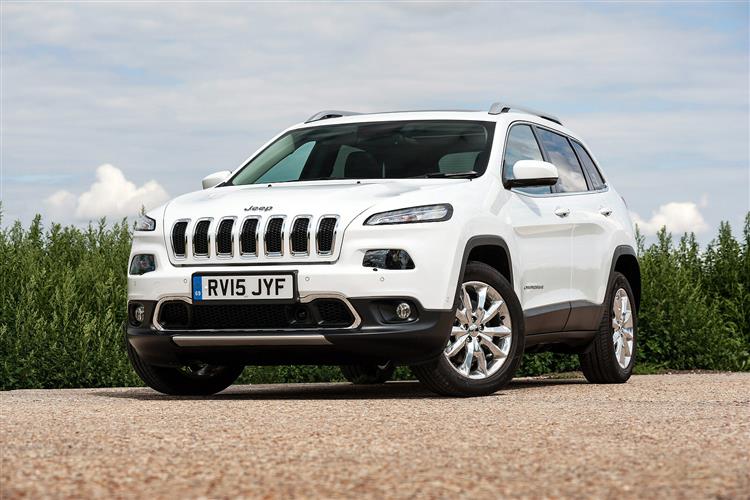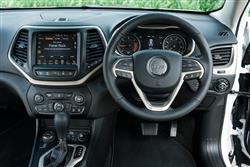This is a sample, showing 30 seconds of each section.
A MORE FASHIONABLE CHEROKEE (some text hidden) SECTIONED_new_jeepcherokee_2015
By Jonathan Crouch
Introductionword count: 141
Jeep reckons that their Cherokee was the 'car that created the SUV segment', which makes you picture the tough, rough off roader this model used to be - but wasn't by the time of the launch of this 'KL'-series model in 2014. Forget setsquare styling and agricultural underpinnings: this fifth generation model was very different - like no Cherokee we'd seen before. Its chassis was more car-like and, in diesel form anyway, its off road credentials were less pronounced, though there was still a clever Selec-Terrain traction control system to offer more capability than most rivals could provide. This won't be a car for everyone but it's a different, welcome contender if you're looking for a RAV4-class mid-sized SUV from this era or shopping for a model from the 2014-2020 period at the upper end of the Qashqai-class family-sized Crossover segment.
Modelsword count: 9
(5dr SUV - 2.0/2.2 CRD diesel / 3.6 petrol)
Historyword count: 446
'Cherokee' always used to be Jeep's bread and butter brand. This was the first car they first launched in Europe and it used to form the bedrock of their range, until the Americans expanded it upwards with the Grand Cherokee and later downwards with Patriot and Compass models. The brand will tell you that this vehicle's origins lie with the Willys-Jeep that played its part in winning World War II - hence the 'Since 1941' motif on this car's steering wheel. The company's tougher Wrangler model though, has a more direct bloodline to that design. No, the Cherokee has always been a different kind of product, one born out of Jeep's post-war need to make its offerings suit a wider market. Which was why in 1963, Willys-Jeep underpinnings were used to create a model called the Wagoneer - a vehicle you could actually use as rugged family transport. The idea caught on and when the brand saw the need to introduce a more affordable two-door Wagoneer variant in 1974, they christened the car the 'Cherokee'. If you know the name, then the version you'll probably remember is the second generation 'XJ' design that sold for 17 years from 1984 and established the 'Cherokee' name as shorthand for properly capable compact SUV motoring. Third and fourth generation 'KJ' and 'KK' versions followed in 2002 and 2008 respectively, sold as 'Jeep Liberty' models in the USA but still badged 'Cherokee' in Europe. In truth though, neither properly captured the spirit of the MK2 design. By 2014 though, Jeep decided that it was time for a version that did - a tough brief given that a car of this kind must in the modern era live in a very different world and sell to a very different kind of customer from the one who might have been easily satisfied with an old 'XJ'. Which is why this MK5 'KL'-series model, launched here in mid-2014 and sold as 'Cherokee' everywhere, was such a very different car to its predecessors. To be frank, it was always going to be anyway, given the Jeep brand's modernday ownership by Fiat and the Turin company's preference for re-using platforms across its various brands. For the modern era, the Italians decided, this model would be designed as a tarmac tool first and foremost, which is why in 'KL'-series form, it sat on the underpinnings of an Alfa Romeo Giulietta hatchback. Yet signs of Cherokee DNA still remained, both in the unusual styling and also in a mechanical specification which aimed to position the car as the most capable choice in its segment. It sold until 2019, after which it wasn't replaced for the UK market.
What You Getword count: 241
There's no doubt that this fifth-generation Cherokee was distinctive - and rather radical. Though the trademark trapezoidal wheel arches and the seven-bar front grille remained constant, there wasn't much else that linked this model to its predecessors. The styling concept here was delivered in two parts, with a smooth and flowing top half that extends down to a kink in the beltline that visually transitions you into the tough, durable lower body. Even the styling flourishes have practical application - take the slim daytime running lights positioned above projector headlamps: they sit high for water fording. The styling at the rear, though less controversial, is equally neat, based around big LED tail lamps and a tailgate that extends right down to a rear bumper that incorporates fog lights and reflectors. Raise it and you'll be lugging your packages over a low loading lip into what was one of the largest cargo areas in the class in this period, 591-litres in size. And up-front? Well, apart from the branded three-spoke steering wheel, there's nothing that's especially Jeep-like, which is perhaps why that wheel feels the need to parade its 'since 1941' motif. Still, it's neat and reasonably up-market thanks to a design approach shared with the company's bigger Grand Cherokee model. Pride of place in the centre of the fascia is reserved for the 'Uconnect' TFT colour touchscreen, five inches in size in entry-level versions but a biggest-in-class 8.4-inches in plusher versions.
To see the full road test text contact us on 0330 0020 227
Pictures (high res disabled)

.jpg)
|
.jpg)
|
.jpg)
| |||
.jpg)
|
.jpg)
|
.jpg)
| |||
.jpg)
|
.jpg)
|

|
Scoring (subset of scores)
Category: Crossover or SUV 4x4s
| Performance | |
| Handling | |
| Comfort | |
| Space | |
| Styling, Build, Value, Equipment, Depreciation, Handling, Insurance and Total scores are available with our full data feed. | |



